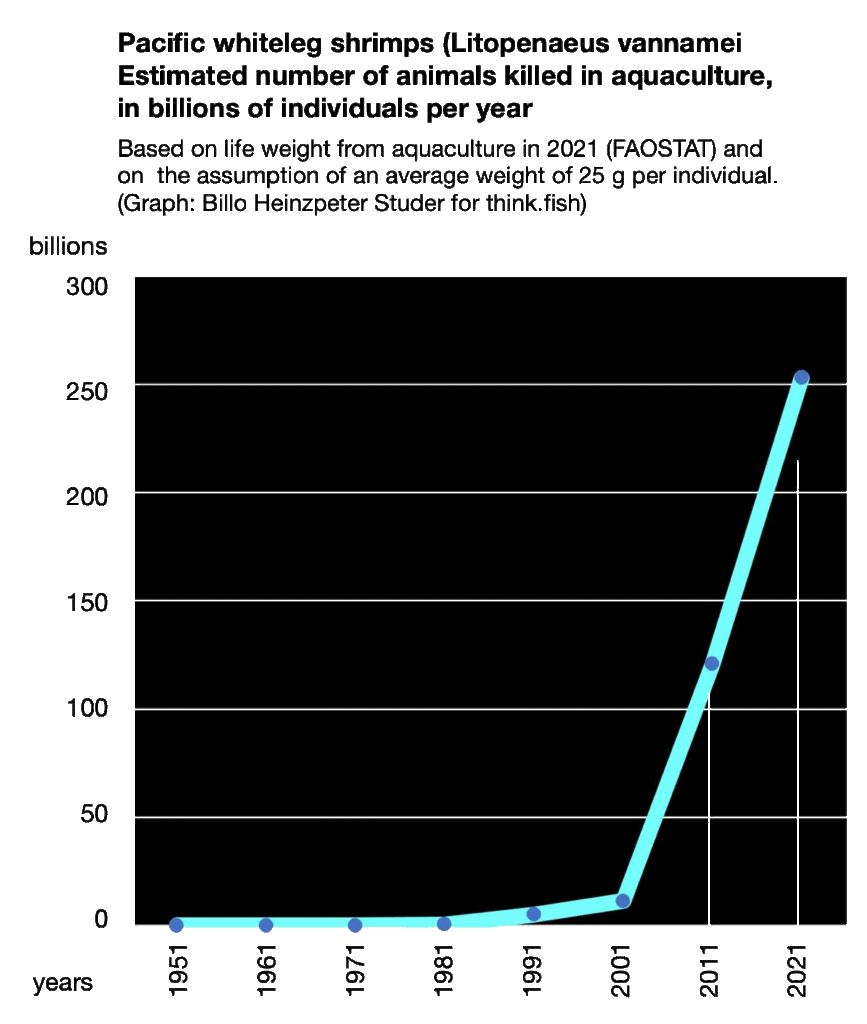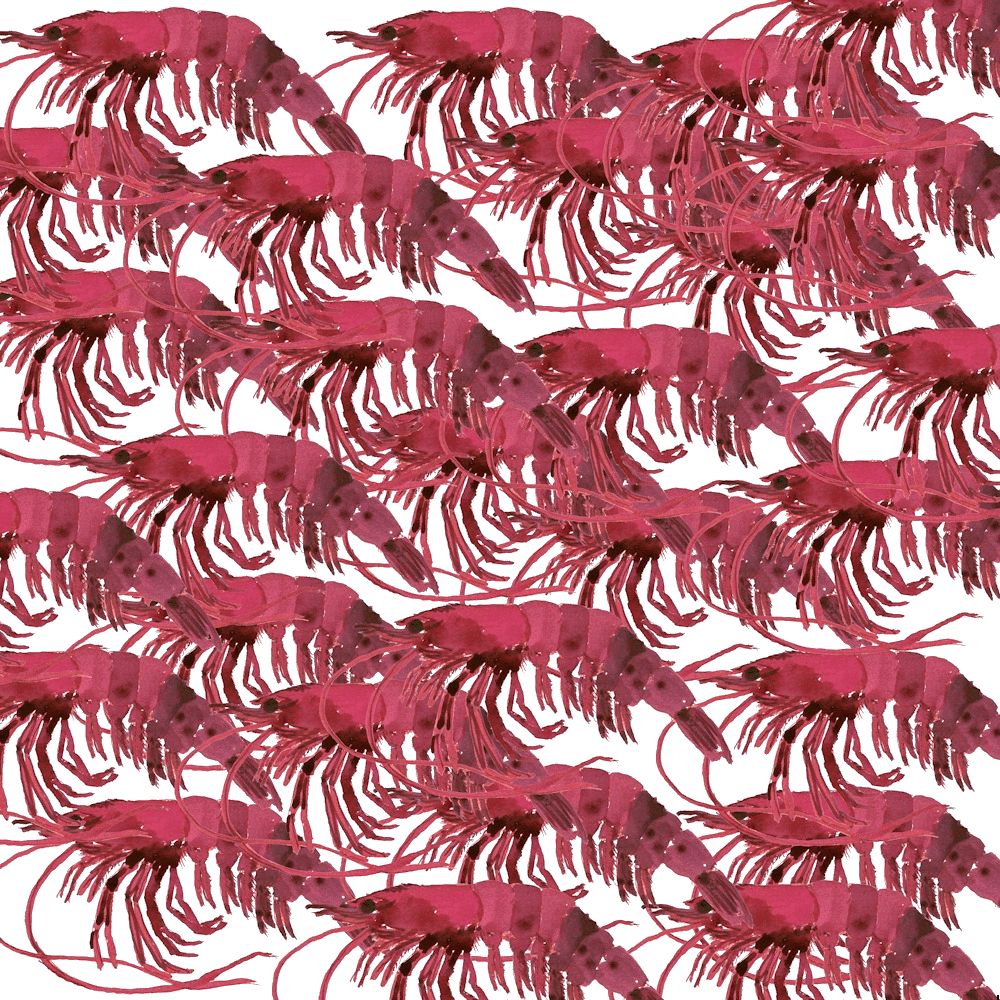A study [1] published in 2022 concludes that ’still little is known about some key parameters related to the five welfare dimensions, as they might be applied to penaeid shrimp‘ — in stark contrast to the knowledge on nutritional needs, stress physiology, immunology and disease control in shrimp farming.
According to the authors, shrimp aquaculture still faces challenges like developing best practices, staff training, monitoring of aquatic environment and animal behaviour, and a welfare assessment throughout the entire life circle.
A similar study [2] published in 2023 argues that welfare of shrimps ‚cannot be communicated to the consumer in a scientifically sound manner‘. The behaviour of decapod crustaceans suggests that they perceive pain perception, the authors admit, ‚but distress has rarely been evaluated under routine aquaculture conditions and markers for chronic stress detection need to be identified‘. Therefore, ‚a comprehensive assessment of chronic stress should be carried out‘ across all life stages. ‚We need evaluation criteria for animal welfare in crustacean farming‘, as the lead author explains in an interview [3] where he states that in addition to identifying stress parameters, the growing potential of automated behavioural assessment should be exploited.
Can research improve shrimp welfare?
Will research of the kind solve the problem of lack of welfare for shrimps? Science itself provides doubt. A look at the findings on the ethology and the welfare of Pacific whiteleg shrimps (Litopenaeus vannamei [4]) and Giant tiger prawns (Penaeus monodon [5]) shows that most of the essential needs of these species cannot be met in aquaculture, not even when a farmer does best as he can. Commercial farming will never be able to provide the horizontal and vertical dimensions needed to provide the individuals with the space and substrate they require in their natural habitat, consequently, aggression and stress are an issue, and suffering at the time of slaughter is yet unresolved. So, why farm shrimps of all aquatic animals?

There is a second good reason to ask: why shrimps? Let’s look at the most farmed crustacean species, L. vannamei, which is one of the species with the highest number of animals killed per year for human food [6]: In 2021, harvest was 6’324’549 tonnes of farmed and 24’043 tonnes of wild catch |7], which transforms in estimates of animals killed per year from over 100 billion to over 1200 billion animals, depending on the market size ranging from 5 to 57 grams per individual [8].
Only the Peruvian anchoveta (Engraulis ringens) is affected in similar numbers, estimated between 139 and 555 billion animals killed per year [9]. However, there is a huge difference between the human impact on the two species: Anchovies are caught in the wild, i. e. they lived under their natural conditions, whereas shrimps are mainly farmed. In the case of L. vannamei only 4 percent of the live weight lifted annually are wild catch. This disproportion is far form being self-evident; farming of L. vannamei (and of shrimps in general) is a very recent phenomenon, as shown in the graph.
To put it bluntly:
- Do we really need research to improve details in the life of farmed shrimps when we know that no farming system will ever be able to cope with their natural needs?
- And do we really need to eat very small animals, knowing that they have to be killed in enormous numbers to fill our plate?
What can be done?
- You cannot directly influence the fact that many persons are craving for shrimps
- Instead, you could reconsider your own consumer behaviour.
- And you could bring up the issue when the opportunity arises and provide information of this kind.
Sure, there are some shrimps farmers who really try hard to do the best, also for the animals, but they are few and will not be able to cover the high and ever growing demand for shrimps. Be happy when you found such a farmer and enjoy the delicatesse with due containment, maybe once a year.
PS:
Should you be a shrimp farmer or a shrimp vendor and be convinced that you do verifiably better, please let us know, either by leaving your comment here or by writing a post in our group.
think.fish is a place where more than just one side of the coin can be told. (Please check our rules first.)
Title picture:
Pacfic whiteleg shrimps Litopenaeus vannamei (Drawing by Kasia Jackowska)
References:
[1] Amaya Albalat et al (2022): Welfare in Farmed Decapod Crustaceans, With Particular Reference to Penaeus vannamei.
[2] Sven Würtz et al (2023): Welfare of Decapod Crustaceans with Special Emphasis on Stress Physiology.
[3] Sven Würtz: Wir brauchen Bewertungskriterien für das Tierwohl in der Krebstierzucht
[4] https://fair-fish-database.net/db/21/farm/shortprofile/
[5] https://fair-fish-database.net/db/21/farm/shortprofile/
[6] Maybe with the exception of farmed insects, but then, insects are sentient as well, see e.g: Claudio Carere, Jennifer Mather (Eds., 2019): The Welfare of Invertebrate Animals
[7] FAOSTAT https://www.fao.org/faostat/en/#home
[]8] Shrimp size chart


Schreibe einen Kommentar
Du musst angemeldet sein, um einen Kommentar abzugeben.